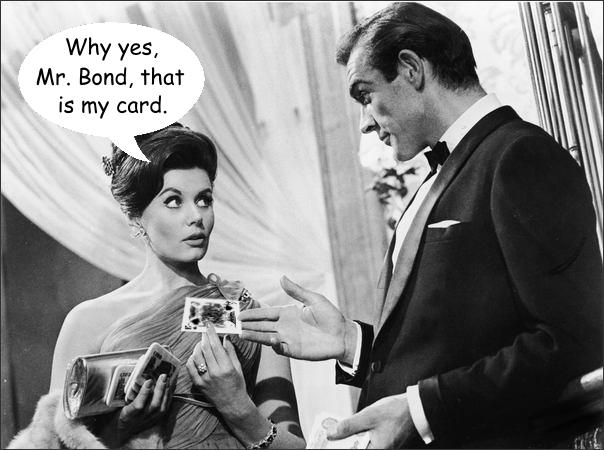James Bond, Card
Man
(11/25/2010)

I was hanging out at The Magic Apple on a recent Saturday afternoon watching the card men do their thing (this has become one of my favorite things to do) when I had one of those little moments of insight. My buddy Michael Rangel (a wonderful magician who was nice enough to appear in my Incandescence video) was working out the handling of a routine with another magician when he changed something quite small: the way the deck was cut to the table. Instead of picking the top half, bringing it forward a few inches and putting it down on the table the way someone like me might do it, he pivoted the lower half of the deck out of the way of the upper half and just let the upper half drop to the table. “Economy of motion,” he said.
Honestly, at this moment, I can’t remember what the trick was, but the way Mike cut those cards I remember vividly. I know that a lot of disciplines that center on human movement (like dance and martial arts) strive for economy of motion, but at that moment, the phrase reminded me of something I’d heard some of my acting friends talk about, a technique for movement analysis developed by Rudolf Laban.
Now, my knowledge of Laban’s theories is largely limited to what I’ve gleaned from barroom conversations and Wikipedia, but damn it, this is a blog, and if bloggers limited themselves to what they knew about, well, we’d be writing books.
So here goes: Laban’s system was an attempt to categorize all human movement and his discoveries were applied to acting by Yat Malmgren – Malmgren gave private lessons to Sean Connery for a year just before Connery landed the Bond role. I seem to recall one of my drunken actor friends poking my chest with a chicken wing as he insisted that the Laban-Malmgren technique was a huge influence on Connery’s Bond performance.
Laban identified the following categories of movement:
Light (no obstacles, airborne, balloon-like) or Strong (overcoming resistance)
Direct (purposeful, focused on a target) or Flexible (absorbing, allowing
oneself to be influenced)
Sustained (flowing) or Broken (renewing one’s energy very quickly all
the time)
The eight possible combinations of these movement qualities correspond to eight different archetypes. I remember my drunken actor friend searching the barroom floor for unshelled peanuts as he identified the specific choices Connery used for Bond (Strong, Direct, Sustained, I seem to recall – Direct was definitely one of them). Bond was not flexible, you could not influence him – when he did something, it was the most important thing in the world and his motions were lean, clean and efficient. It was “Economy of motion”.
That directness gives an image of power, elegance and grace. These are qualities that many magicians strive for but far from all of them achieve.
Jon Armstrong has a great thought experiment he asks magicians to do: if your magician character was a comic book superhero which one would it be? It’s a very useful game – it focuses the magician on his abilities, because his or her favorite superhero is unlikely to be able to do absolutely everything (unless it’s Doctor Strange who is, after all, a magician – which kind of screws up Armstrong’s experiment, so forget that one). The point is, a vivid magician character, like a vivid superhero, is unlikely to be able to do everything – he has a defined set of abilities – if Superman could suddenly breathe underwater, all the fans would cry foul. Limiting what you can do doesn’t diminish your character – it helps define it and so makes it more vivid.
Just as with the Armstrong test, I think many magicians would benefit from thinking about Laban and Malmgren when choreographing material – how does your character move? Is every movement in every effect contributing to your character or do some chafe against it and make it less well-defined?
Now, I think there are no right and wrong choices here – only consistent ones and inconsistent ones (and there may be good reasons for inconsistency though I’m sure there aren’t many). Do those flouishy hand waves as the magic happens fit the rest of your routine? Does that moment of misdirection when you suddenly remember to get the pencil from your pocket actually stand out since it’s the only moment of indirection in an otherwise Direct routine?
There are certain generalizations you can make about how certain styles of magic incorporate certain styles of movement, “rules” a magician could either adhere to or play with. Most manipulators I would classify as Light while most illusionists I think are Strong. Most card men seem direct (though not all: Tamariz seems to me to be Flexible). If a magician is dressed elegantly, he’s more likely Direct, and if he’s dressed in bright colors (like a purple top hat), he’s more likely Flexible. Stage magicians are more likely to be Sustained and comedy magicians are more likely to be Broken (I say that to describe their movement, not their psychological make up. Although...)
A part of me thinks that this kind of analysis is academic. Then I think of James Bond – there are a lot of factors that makes his character one of the most popular in film history and Connery's thoughtful use of Laban-Malmgren movement analysis seems to be one of them.
(By the way, Yat Malmgren’s students also include Colin
Firth, Anthony Hopkins, Russell Brand, Paul Bettany and another one of the
good Bonds, Pierce Brosnan – that’s from Wikipedia, not my drunken
actor friend, who I recall claimed that Malmgren taught Johnny Walker and
Jose Cuervo).
Go Back to Film and Magic Blog

©Chris Philpott 2011. All rights reserved. Original designs and content
by Kathleen Breedyk and Chris Philpott.
Contact Us .

